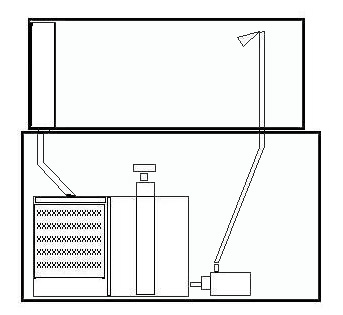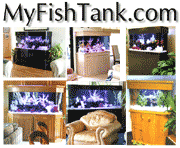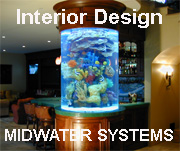|
Wet Dry Trickle Filters
Back when the reef tank concept was introduced
to the U.S in 1983 it consisted of a glass tank that had a filtration unit
below. This filtration unit was called a Wet Dry filter because it allowed
the water to come in contact with two environments; one that exposed the
water to high amounts of air / oxygen ( the dry part ), the other was in
a submersed environment ( the wet part ). The concept behind the Wet Dry
filter was that the waste laden water could be dealt with in a compartmental
fashion, and that the bacteria's that form the biological aspects of filtration
would become more effective.

The path that the water took as it left the tank
was one where the surface water was 'skimmed' as it flowed over the top
of a glass box mounted into the entire corner of the tank. This box, called
a surface skimmer, allowed the organics that form a skin at the surface
of the water to be removed thus allowing the water to more effectively
exchange gases ( oxygen and carbon dioxide ). Within the surface skimmer
box was a filter pad that trapped out particles of debris that the water
carried.
After the water passed through the filter pad
it was routed down and out of the bottom of the tank and flowed into
the top of the Wet Dry filter chamber. The design of the filter allowed
the filter chamber to be only one half full of water. This top half, being
above the water level was the 'dry' portion of the filter
At the top of the original 'Mini-Reef' brand filters
was a rotating sprinkler that rained the water, from the tank, evenly over
a spiral wound filter media called DLS ( double layered spiral ) pad. The
rotating sprinkler turned as a result of the force of the water passing
through it and the DLS consisted of two layers; one that was a thin filter
material, the other was a wiry mesh. These two layers rolled up together
allowed air to penetrate between the layers of the thin filter material
thus providing air / oxygen to the bacteria's.
Later designs of the 'dry' section replaced the
rotating sprinkler with a horizontal plate, called the Drip Plate, that
had rows of holes evenly drilled into it and more effectively distributed
the water over the filter media. In place of the DLS were plastic balls,
called bio-balls. These balls were in various shapes ranging from women's
hair curlers to shotgun shell wadding to circular frame like structures
( Jager Tri-Packs ) to spheres with small rods.

The advantage of the DLS pad or Bio-Balls was that
the water was distributed over the media in thin layers. These filter media's
offered tremendous surface area for bacteria's to adhere to, as well as,
allowed air ( oxygen ) down into the media. The increased amount of oxygen
being exposed to, in combination with the thin sheets of waste laden water
passing over, the bacteria's was ultimately a far more effective bacteria.
Keep in mind that it is the amount of oxygen that allows the bacteria to
oxidize waste.
As a side note, this method of biological filtration
is not a new method. Sewage waste treatment and pollution control plants
have been using variations of this concept for years.
The 'wet', or lower half, was submersed. Generally
this area held a form of large granule calcareous gravel. The idea was
that the calcareous media would aid in maintaining a higher calcium content
and that other bacteria's being held in a submersed, or lower oxygen, environment
would host de-nitrifying bacteria's, as well as, trap out other particulate
matter.
Within time it was realized that this submersed
area was really not that effective, and that calcium could be obtained
in other methods instead of relying on the gravel in the wet section. Additionally,
it was recognized that the gravel in this area trapped and held too much
debris which lead to a build up of various nutrients, coupled with the fact
that it was not an area that lended itself to convenient clean. With this
in mind the media in the wet section was eliminated and this area became
a free-flow area that one could place a bag of activated carbon, or some
other bagged filter media.
For all intents and purposes the evolution of
the European Wet Dry Filter became a 'dry' filter.
Now, let me throw you a curve. I believe it was
Julian Sprung ( a prominent aquarium author ) who suggested that a reef
tank could operate without the Dry section. That is to say no DLS or Bio-Balls.
Why ? I have mentioned that the advantage of the Dry section is that the
bacteria's become quite effective when exposed to greater amounts of oxygen,
and this is very true. Ironically they become too effective ! Their ability
to convert waste via the nitrification process is significant, and Julian
suggested that these filters might be the cause of nutrient and algae problems
within the tank. Keep in mind that the live rock in the tank has
a tremendous amount of bacteria's within them, certainly enough for a basic
'low load' reef tank. So out came the bio-media, and within weeks many
hobbyists algae problems either disappeared or subsided significantly,
and no detectable ammonia or nitrite problems.
So, where does this leave the Wet Dry filter ?
Is there a need for it ? YES, in one form or another depending on what
you are doing / keeping. If your aim is a fish-only system definitely yes,
it is far more effective than an Undergravel Filter and helps tremendously
with the oxygen content of the water. If you are striving for a reef system
that has at least one pound of live rock per gallon of water and a low
fish load then a Wet Dry without its bio-media is the suggested way to
go. If you have a heavy load of fish in a reef tank then I would recommend
using the bio-media as due to the amount of food for the fish you are going
to have high levels of nutrients anyhow, and you will need a more effective
biological filter to deal with the heavy load of fish and food waste.
|













